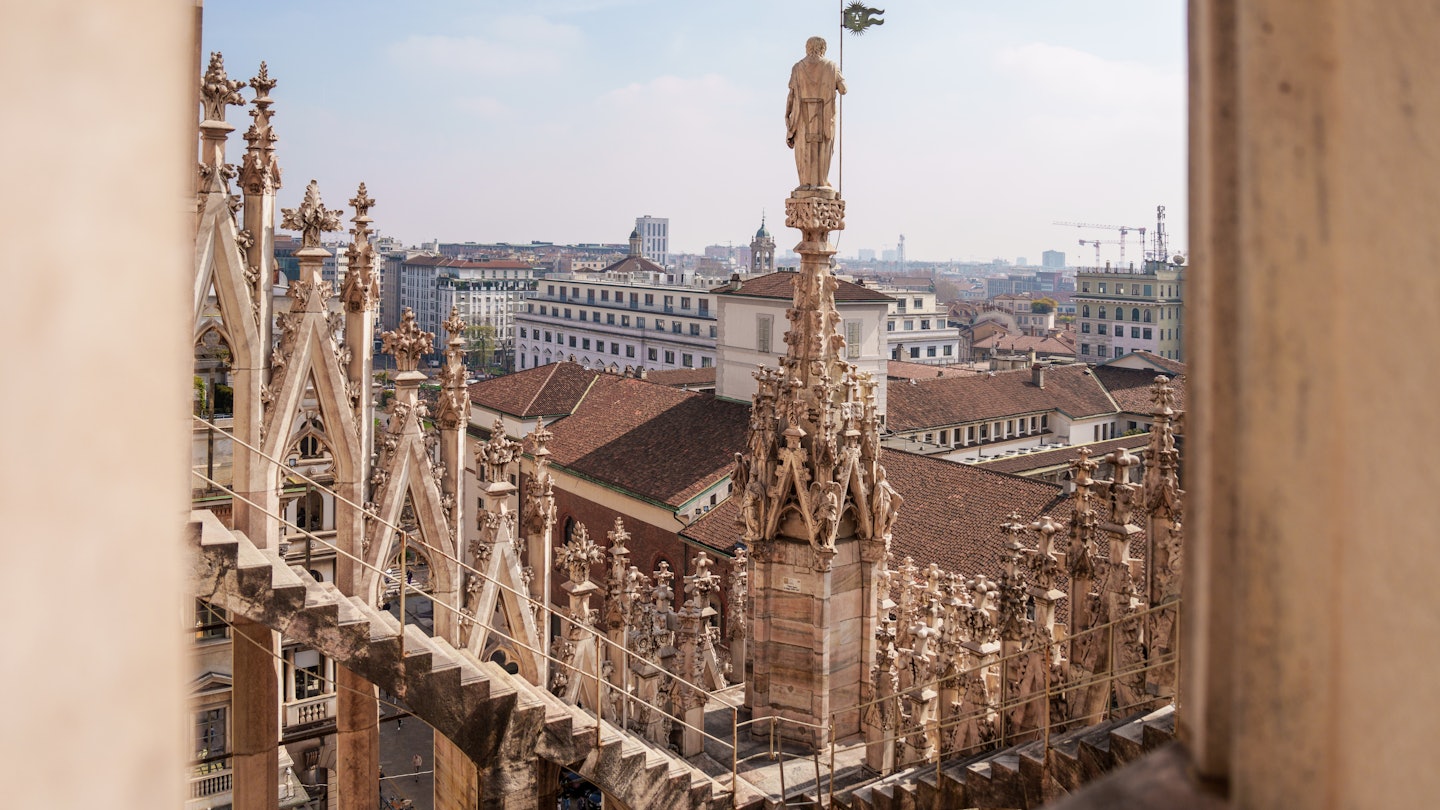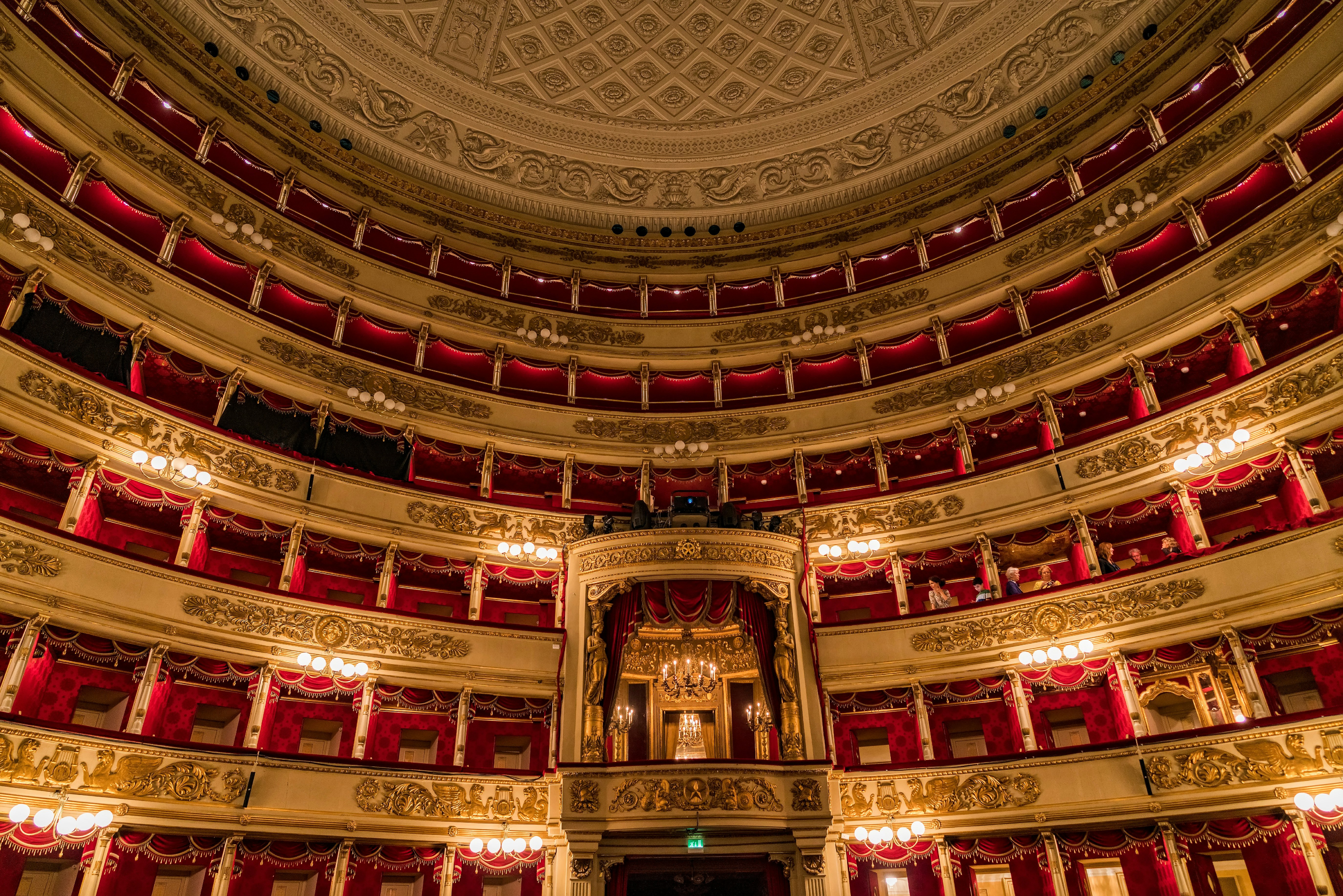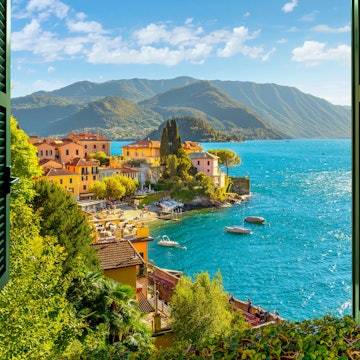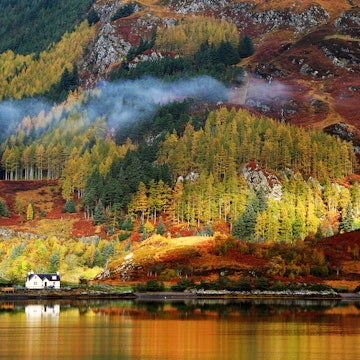

The Duomo in Milan. photo-lime/Shutterstock
Milan is Italy’s most modern and glamorous city, boasting innovative architecture and edgy design at every turn. And yet the past is everywhere, because this lively and dynamic city sits right in the middle of the Po Valley, a region that has truly seen it all in its millennia-long history.
Experience the best of Milan – from museums, art and fashion to dining and cocktails – with our pick of the top things to do.
1. Delve into the Duomo
The Duomo di Milano, or Milan Cathedral, is the symbol of the city. The stunning work of Gothic architecture also happens to be Italy’s largest church (St Peter’s Basilica is in the Vatican State). It’s sure to leave you breathless with its intricately decorated facade and multitude of spires. And sitting right on top of it is the famous golden statue of the Virgin Mary, the Madonnina, another everlasting symbol of Milan.
The square just in front of it, Piazza Duomo, is also pretty important since it could easily be dubbed the heart of the city. Once you’ve taken some pictures with one of the best backdrops Italy has to offer, all you need to do is look around Piazza Duomo and in every direction you’ll find something incredible to head off to.
Planning tip: The good-value €20 combination ticket for the cathedral, roof terraces and more is valid for 72 hours. Buy tickets at the official Duomo ticket office to the right of the facade or online (extra €1.50).

2. See opera, ballet and concerts at the famous La Scala
One of the most famous opera stages in the world, La Scala is where Maria Callas made her debut, Verdi triumphed and Toscanini established his legacy as a virtuoso conductor. Sitting in the crimson and gilt boxes of Teatro alla Scala among the Milanese dressed to impress is one of those moments you won’t forget.
Planning tip: The opera season kicks off on December 7, the day of Sant’Ambrose – Milan’s patron saint – and it typically runs until mid-July. If you’re not a fan of operatic glory, you can also see theater, ballet and classical-music concerts here year-round (except August).
3. Enjoy afternoon cocktails in the birthplace of the aperitivo
Aperitivo – Italy’s answer to happy hour – has become so popular you can find it all over the country, but Milan is where its winning modern-day formula was born. It usually goes from 6pm to 9pm and lets you enjoy an array of nibbles for the price of a cocktail. While traditionally the drink of choice involves Aperol, Campari or vermouth, these days any cocktail will do. Accompanying snacks range from olives and chips to curated small plates or sometimes an all-out buffet, thus catapulting aperitivo to apericena, a hearty near-substitute for dinner.
A good place to partake of the experience is the historic Camparino in Galleria, located inside the Vittorio Emanuele II. It was here as early as the 1920s that the aperitivo was allegedly conceived. The bar has served drinks to the likes of Verdi, Toscanini and Dudovich. Cast-iron chandeliers and mirrored walls trimmed with mosaics of birds and flowers set the tone for a classy Campari-based cocktail.

4. Go window shopping at Galleria Vittorio Emanuele II
With its triumphal arch and sky-revealing glass canopy, it’s easy to see how Galleria Vittorio Emanuele II broke the mold of shopping arcades before it. Built in 1867 and named after the king who unified Italy, the interior is a mix of genteel cafes and haute couture. Historic spots include Biffi restaurant, here since the Galleria’s opening, and the first Prada shop with its original "Fratelli Prada" (Prada Brothers) sign.
Don’t miss the curious tradition of spinning with your heel on the testicles (now a worn-down hole) of the mosaic bull – legend has it this will bring you luck.
Planning tip: Photo hunters should rise early to catch the light on the glowing, mosaicked ceiling vaults.
5. Discover Lombard masterpieces at Gallerie d’Italia
Set in a fabulously decorated 19th-century palazzo (mansion), Gallerie d’Italia houses a striking collection of 18th- and 19th-century Lombard painting. From a magnificent sequence of bas-reliefs by Antonio Canova to luminous Romantic masterpieces by Francesco Hayez, the works span 23 rooms and document Milan’s significant contribution to the rebirth of Italian sculpture, the patriotic romanticism of the Risorgimento (reunification period) and the birth of futurism at the dawn of the 20th century.

6. Tour medieval and Renaissance art at Castello Sforzesco
Lording over Parco Sempione’s southeast side, red-brick Castello Sforzesco was home to the mighty Sforza dynasty that ruled Renaissance Milan. Its defences were designed by da Vinci; Napoleon later drained the moat and removed the drawbridges. Today it shelters seven museums, showcasing parts of Milan’s cultural and civic history, from the medieval equestrian tomb of Bernabò Visconti to Michelangelo’s Rondanini Pietà, his final, and some say finest, piece of work.
Housed in the frescoed ducal apartments, the Museum of Ancient Art has a stellar medieval collection. From paleo-Christian frescoes to the fine equestrian tomb of Bernarbò Visconti and sculpted reliefs depicting Milan’s triumph over Barbarossa, the artworks relate the murderous and ambitious story of Italy’s first city comune. Da Vinci frescoed the octagonal ceiling of the Sala delle Asse (room VIII) while other rooms sport heraldic coats of arms.
Planning tip: Admission to the museum is free on the first and third Tuesday from 2pm, and every first Sunday of the month.
7. See The Last Supper, one of the world's most iconic images
Milan’s most famous painting, Leonardo da Vinci’s The Last Supper, is hidden away on a wall of the refectory adjoining the Basilica di Santa Maria delle Grazie. Depicting Christ and his disciples at the dramatic moment when Christ reveals he is aware of the betrayal afoot, it is a masterful psychological study and one of the world’s most iconic images. Having survived da Vinci’s experimental technique – which caused the painting to deteriorate within 20 years of completion – along with WWII bombings and harmful restoration attempts, the fact the work remains at all is nothing short of a miracle.
Planning tip: Online reservations are released quarterly (for example, in mid-March for June, July or August visits); tickets go quickly.

8. Experience the world of da Vinci at Milan’s massive science museum
Would-be inventors will go goggle-eyed at the Museo Nazionale Scienza e Tecnologia Leonardo da Vinci, the largest of its kind in Italy. It’s a fitting tribute in a city where arch-inventor Leonardo da Vinci did much of his finest work. The 16th-century monastery housing the museum features more than 10,000 items, including outdoor hangars that are home to steam trains, planes and full-sized galleons. The highlight is the da Vinci collection: atmospheric galleries featuring sketches, notebooks and over 170 historical models exploring his ideas and inventions – war machines, castle fortifications, flying apparatuses and canal systems.
9. Stroll Milan's fashion district
Explore the best of the city's fashion in Quadrilatero della Moda. Start at Museo Poldi Pezzoli, where 19th-century nobleman Pezzoli transformed his apartments into themed rooms showcasing the Middle Ages, early Renaissance, and baroque periods. Head up Via Alessandro Manzoni to Alessi, the iconic Italian design store founded in 1921, featuring beautifully crafted utensils by leading architect-designers. Some pieces reside in New York’s MoMA, but this flagship store features everything Alessi has ever done. Continue to Via Monte Napoleone, the Quad’s most important street lined with global luxury brands. Turn up Via Gesù to Museo Bagatti Valsecchi, where two wealthy brothers created one of Italy’s finest house museums filled with Renaissance treasures. Take an espresso break at Cova Montenapoleone, Milan’s oldest cafe (opened 1817). End at Palazzo Morando, the former home of Countess Bolognini, featuring four centuries of artworks and fashion exhibitions.

10. Explore the city's last canals
Milan was once laced with waterways that da Vinci himself had a hand in developing during medieval times. Sadly, in the 1930s the Fascist regime closed them for supposed hygiene reasons and to accommodate the increasing number of cars. Now you can have a drink on the Naviglio Grande and Naviglio Pavese, the city’s most photogenic corner, and imagine what might have been. Both canals are lined with bars, cafes and restaurants that thrum with activity day and night. Naviglio Grande is the place for an aperitivo and on Saturday nights it feels like the whole city is here.
Local tip: On the last Sunday of the month, Naviglio Grande hosts the Mercatone dell’Antiquariato, a sprawling antiques market. For a different view of the canals, hire a bike for some picturesque pedalling past small villages and old cascine (farmhouses).
11. Get inspiration for your home at Milan Design Week in April
The Salone Internazionale del Mobile, the world’s most prestigious annual furniture and design fair, brings crowds from across the globe. Held in April, the fair runs alongside its ever-popular sidekick Fuorisalone, which as the name suggests, covers all design events "outside" the Salone. Fuorisalone animates the entire city for one action-packed week, particularly Tortona, Lambrate and the center. Expect to be inundated with design-related events, parties, large-scale installations and exhibitions.
12. Celebrate the festive season with Sant’Ambrogio
The feast day of Milan’s patron saint, St Ambrose, is celebrated on December 7 with a special mass at the Basilica di Sant’Ambrogio and the large Christmas Fair Obej! Obej! (pronounced o-bay, o-bay). The market sets up in and around Castello Sforzesco, with stalls selling regional foods, sweets and seasonal handicrafts.

13. Find avant-garde art and architecture at Fondazione Prada
Formerly a century-old gin distillery, this sprawling 19,000-sq-m complex in south Milan has been given the Prada touch. At Fondazione Prada several buildings are clad in dazzling 24-carat gold leaf and there’s also a blindingly white 60m-high concrete tower, not to mention a ’50s-style bar designed by Wes Anderson. Conceived by Miuccia Prada and husband Patrizio Bertelli, and designed by Pritzker Prize–winning architect Rem Koolhaas, Fondazione Prada is the slick industrial home of contemporary art, film and multidisplinary projects that often seek to probe our perceptions of modern life.
14. Enjoy a moveable feast on board the ATMosfera
Two of Milan’s historic trams have been renovated to incorporate a restaurant where you can eat your way through a 4-course menu as you tour the city. When you book a table on the ATMosfera, you choose a set menu (vegetarian option available), which you’ll enjoy over the course of 2 hours and 30 minutes amid varnished teak walls, glass lanterns and upholstered benches.

15. Unearth the Codex and Caravaggio in Biblioteca Ambrosiana
One of Europe’s earliest public libraries (built 1609), the Biblioteca e Pinacoteca Ambrosiana was more a symbol of intellectual ferment than of quiet scholarship. It houses countless volumes and manuscripts, including Leonardo da Vinci’s priceless collection of drawings, the Codex Atlanticus. A 24-room art gallery exhibits Italian paintings from the 14th to the 20th century and famously features Caravaggio’s Canestra di frutta (Basket of Fruit), which launched both his career and Italy’s ultrarealist traditions. Though unfinished, the intimate Portrait of a Musician (painted in 1485) is a masterpiece by da Vinci and his only known male portrait painting.
16. Experience Milan’s top exhibitions at Palazzo Reale
The once opulent Palazzo Reale hosts blockbuster exhibits, attracting serious crowds to wide-ranging works. Recent shows have focused on legendary photographers, fashion and its connection to Italian culture, retrospectives of famed painters like Cézanne and Renoir, Dalí and the creative process, and the myth of Napoleon as depicted by artists over time.
17. EXPLORE CHURCHES BEYOND THE DUOMO
While the Duomo might be the chiefest among the Milanese churches, it’s definitely not the only one. You probably can’t expect to visit all of them, but you should consider dropping by the Basilica di Sant’Ambrogio, one of the oldest in Milan and also the one dedicated to its patron saint. Another favorite is the Chiesa di San Maurizio, also known as the “Sistine Chapel of Milan” because of the vast frescoes that decorate its entire ceiling.
















